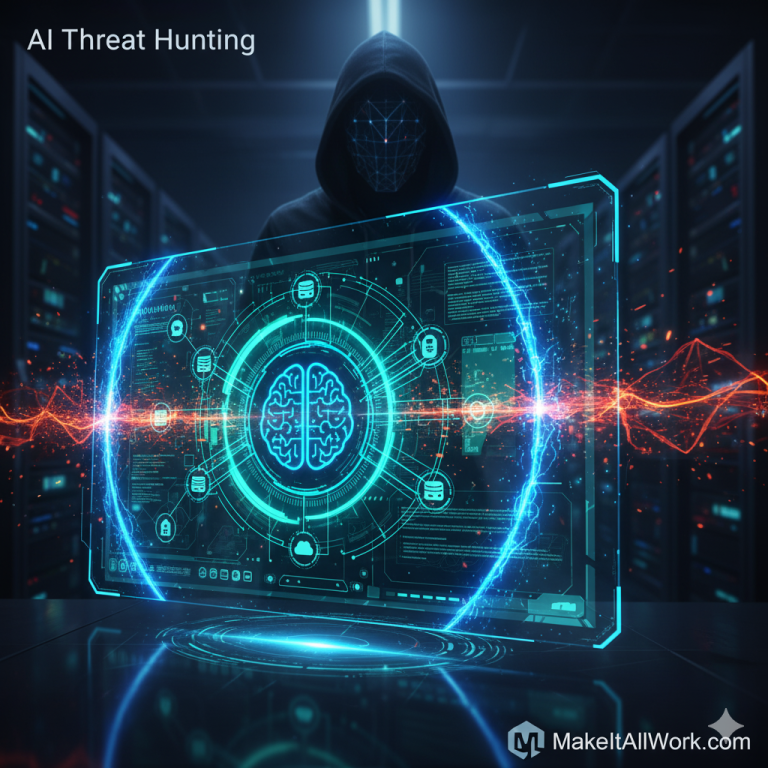AI’s Role in Threat Hunting: Teaching Machines to Think Like Hackers

At MakeItAllWork, we recognize that the digital world moves fast—and unfortunately, cyber threats move even faster. For small web development companies, keeping up with the sheer volume and sophistication of modern attacks can feel impossible. Traditional security tools often wait for an attack to happen before reacting.
But what if your defenses could proactively seek out dangers? What if your security system could think like a hacker, predict their moves, and neutralize the threat before a breach ever occurs?
Welcome to the future of cybersecurity, powered by Artificial Intelligence (AI) and Machine Learning (ML). This isn’t science fiction; it’s the cutting edge of Threat Hunting, and it’s essential for protecting your business.
Let’s explore how AI is revolutionizing the fight against cybercrime in a conversational Q&A format.
What exactly is “Threat Hunting,” and how is it different from normal security?
Traditional security (like antivirus or firewalls) is based on known threats. It’s reactive, like setting up an alarm system: it waits for a known bad guy (a blacklisted IP address or known malware signature) to trip the wire.
Threat Hunting is proactive. It assumes that threats have already bypassed those traditional defenses and are lurking silently within your network. Instead of waiting for an alarm, skilled analysts—and now, AI—actively and ceaselessly search through vast amounts of data for suspicious or anomalous patterns that suggest a hidden attacker is present.
It’s like hiring a detective to patrol your property, looking for signs of entry or strange behavior, rather than just waiting for the burglar alarm to sound.
Where does AI fit into this? Aren’t humans better at hunting threats?
Humans are excellent at intuition and deep analysis, but they cannot handle the scale and speed of modern network traffic. That’s where AI shines.
- The Scale Problem: A small company network generates millions of logs, alerts, and packets of data daily. A human team simply can’t review all of that.
- The AI Solution: AI and Machine Learning algorithms can process billions of data points in seconds. They are trained to establish a baseline of “normal” behavior for your network (when staff log in, what servers they access, typical file sizes, etc.).
When an event deviates from this normal baseline—even slightly—the AI flags it instantly, allowing security analysts to focus their limited time on genuine, high-priority threats.
How does AI actually “think like a hacker”?
AI doesn’t have emotions or intent, but it uses sophisticated algorithms to anticipate malicious behavior. We essentially train the machine on two key things:
- Spotting Anomalies: If a user account that normally logs in at 9 a.m. from New York suddenly tries to log in at 2 a.m. from Russia, the AI spots this anomaly immediately. If a standard web server suddenly starts compiling a large executable file (which it shouldn’t), the AI sees the deviation from the norm.
- Mapping Attack Patterns: AI can be trained on known cyber attack methodologies (like the MITRE ATT&CK framework). By analyzing millions of past breach scenarios, the AI learns to recognize the sequence of actions an attacker takes—even if the individual steps look benign on their own. For example, a successful attack often involves scanning, escalating privileges, and then exfiltrating data. AI connects these dots long before a human could.
Can AI prevent zero-day attacks (attacks nobody has seen before)?
This is one of AI’s most powerful capabilities. Traditional security is useless against a zero-day attack because it doesn’t have a signature to match.
However, AI’s reliance on behavioral analysis allows it to detect never-before-seen threats. If a piece of unknown malware starts behaving like known malicious software—say, it begins encrypting multiple files simultaneously or attempting unauthorized memory access—the AI recognizes this malicious behavior and can often contain the threat before it completes its mission, regardless of the attacker’s code.
What are the key benefits of using AI for Threat Hunting for a small business like ours?
For small and medium-sized businesses (SMBs), AI-powered threat hunting provides:
- Leveling the Playing Field: You gain access to the same detection speed and sophistication used by massive corporations.
- Reduced False Positives: AI learns what is truly “normal” for your business, meaning your team gets fewer false alarms and can dedicate their time to development, not chasing ghosts.
- Faster Response Time: The speed of AI detection shrinks the time hackers have to operate, minimizing the damage and cost of a breach.
- Proactive Defense: You move from reacting to breaches to actively preventing them, protecting your reputation and client data.
Upgrade Your Defenses with AI Speed!
In the world of cybercrime, the attackers are already leveraging automation to increase their speed and volume of attacks. You need AI on your side to fight back. Simply having an updated firewall and antivirus isn’t enough to defend against sophisticated, stealthy threats that utilize AI’s own speed against you.
At MakeItAllWork.com, we don’t just build great websites; we secure them. We specialize in implementing advanced, AI-driven security solutions tailored for the needs of small web development companies, giving you enterprise-level protection without the enterprise-level cost.
Ready to stop waiting for the alarm to sound and start proactively hunting down threats?
Contact Us today for a free consultation on integrating AI-powered threat hunting into your security architecture. Let us help you teach machines to think like hackers, so you never have to worry about them getting ahead of you.

 ALL BLOGS
ALL BLOGS


